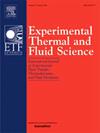Water droplet impact-freezing behaviors on cold superhydrophobic cylindrical surfaces
IF 3.3
2区 工程技术
Q2 ENGINEERING, MECHANICAL
Experimental Thermal and Fluid Science
Pub Date : 2025-09-07
DOI:10.1016/j.expthermflusci.2025.111613
引用次数: 0
Abstract
The impact-freezing behavior of droplets on cold superhydrophobic cylinders was investigated using silica-based coating and a self-constructed low-temperature droplet impact experimental platform. The effects of surface temperature, droplet impact velocity, and surface curvature on droplet dynamics and freezing behavior were systematically investigated. Experimental results revealed that the surface temperature predominantly inhibited droplet retraction, with limited influence on the spreading stage. The effect of surface curvature was found to be more complicated. Droplets tended to freeze rather than rebound at smaller curvature diameters, highlighting the dominance of heat transfer. As the curvature diameter increased, fluid flow effects became more pronounced, leading to a larger circumferential spreading factor. Then, this factor gradually decreased with further increases in diameter and eventually stabilized. Experiment also showed that the circumferential maximum spreading factor was positively correlated with both the surface supercooling degree and the Weber number, but negatively correlated with the curvature diameters ratio. Notably, the influence of surface temperature on impact-freezing was highly related to surface curvature. These findings provided insights into optimizing structured superhydrophobic surfaces for anti-icing performance.
超疏水圆柱表面水滴的冲击冻结行为
采用硅基涂层和自行搭建的低温液滴撞击实验平台,研究了液滴在超疏水圆筒上的撞击冻结行为。系统地研究了表面温度、液滴撞击速度和表面曲率对液滴动力学和冻结行为的影响。实验结果表明,表面温度主要抑制液滴缩回,对扩散阶段的影响有限。表面曲率的影响更为复杂。液滴倾向于在较小的曲率直径处冻结而不是反弹,这突出了传热的优势。随着曲率直径的增大,流体流动效应更加明显,导致周向扩散系数增大。随着直径的进一步增大,该因子逐渐减小,最终趋于稳定。实验还表明,周向最大扩散系数与表面过冷度和韦伯数呈正相关,与曲率直径比呈负相关。值得注意的是,表面温度对冲击冻结的影响与表面曲率高度相关。这些发现为优化结构超疏水表面的抗冰性能提供了见解。
本文章由计算机程序翻译,如有差异,请以英文原文为准。
求助全文
约1分钟内获得全文
求助全文
来源期刊

Experimental Thermal and Fluid Science
工程技术-工程:机械
CiteScore
6.70
自引率
3.10%
发文量
159
审稿时长
34 days
期刊介绍:
Experimental Thermal and Fluid Science provides a forum for research emphasizing experimental work that enhances fundamental understanding of heat transfer, thermodynamics, and fluid mechanics. In addition to the principal areas of research, the journal covers research results in related fields, including combined heat and mass transfer, flows with phase transition, micro- and nano-scale systems, multiphase flow, combustion, radiative transfer, porous media, cryogenics, turbulence, and novel experimental techniques.
 求助内容:
求助内容: 应助结果提醒方式:
应助结果提醒方式:


